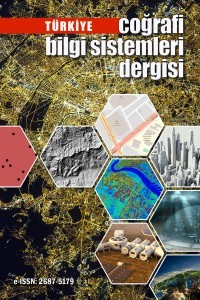İnsansız Hava Araçlarında Çarpışma Önleyici Sistem Optimizasyonu
Askeri ve sivil hava sahalarının ortak kullanım zorunluluğu, uçak sayısı ve seferlerindeki artış, teknolojik gelişmelere uyum süreci gibi problemlerin yanısıra, havacılık uygulamalarının bir başka mücadele konusu da uçuş güvenliğinin optimizasyonudur. İlgili sektörlerin Ar-Ge çalışmaları, fen ve mühendislik anabilim dallarından alınan çözüm odaklı fikirler, CBS (Coğrafi Bilgi Sistemleri) ve yapay zeka benzeri analiz ve modelleme platformları, havacılık çalışmalarındaki sinerjiyi sürekli dinamik tutmaktadır. Özellikle İHA (İnsansız Hava Araçları), gerek sivil, gerekse askeri uygulamalarda bir çok ihtiyaca cevap vermekte, kapsamı giderek artmakta ve ekonomik yatırımlara açık bir pazar olarak görülmektedir. İHA sistemleri ayrıca, atmosferik değişkenliklerin takibi, 3D CBS destekli topoğrafik analiz ve modelleme ile anlık karar destek platformu içermesi, teknolojik gelişmelere kolay adapte olabilmesi, uzaktan erişimli kullanım kolaylığı ile can kaybı veya yaralanma riski oluşturmaması, güvenlik açısından riskli bölgelerde etkin kullanım gibi avantajlara sahiptir. Uygulama alanlarındaki artışa paralel olarak, kullanılan İHA’ların sayıları da hızla artmaktadır. Bu çalışmada, havada çarpışma olasılığını tetikleyen ve besleyen faktörler değerlendirilerek mevcut durum incelenmiş, çarpışma önleyici sistemlerin İHA entegrasyonu içerikli öngörü ve fikirler geliştirilmiş ve hava sahasının daha etkin ve güvenli kullanımına yönelik önerilerde bulunulmuştur.
Anahtar Kelimeler:
İHA, Çarpışma Önleyici Sistem, Entegrasyon, CBS
Anti-Collision System Optimization in Unmanned Aerial Vehicles
In addition to problems such as the necessity of joint use of military and civil airspaces, the increase in the number of aircraft and flights, the adaptation process to technological developments, another challenge of aviation applications is the optimization of flight safety. R&D studies of relevant sectors, solution-oriented ideas from science and engineering departments, GIS (Geographical Information Systems) and artificial intelligence-like analysis and modeling platforms keep the synergy in aviation studies dynamic. Especially UAV (Unmanned Aerial Vehicles) respond to many needs in both civil and military applications, its scope is increasing gradually and it is seen as a market open to economic investments. UAV systems also have advantages such as monitoring atmospheric variability, including 3D GIS supported topographic analysis and modeling and instant decision support platform, easy adaptation to technological developments, ease of use with remote access, no risk of loss of life or injury, and effective use in risky areas in terms of security. Parallel to the increase in application areas, the number of UAVs used is also increasing rapidly. In this study, the current situation was examined by evaluating the factors that trigger and feed the possibility of air collision, foresight and ideas were developed for the integration of anti-collision systems to unmanned aerial vehicles, and suggestions were made for more effective and safe use of airspace.
Keywords:
UAV, Anti-Collision System, Integration, GIS,
___
- Acar Ö B (2013). İnsansız Hava Araçları ve Sertifikasyon Çalışmaları STANAG 4671 & STANAG 4702, 29-54.
- Barnhart R K (2012). Introduction to Unmanned Aircraft Systems. CRC Press, ISBN: 978-1-4398-3521-0.
- Billingsley T B (2006). Safety analysis of TCAS on Global Hawk using airspace encounter models. Doctoral dissertation, Massachusetts Institute of Technology, 66p.
- DeGarmo M T (2004). Issues Concerning Integration of Unmanned Aerial Vehicles in Civil Airspace. Center for Advanced Aviation System Development. Virginia, 9-25.
- DeGarmo M T & Nelson G (2004). Prospective Unmanned Aerial Vehicle Operations in the Future National Airspace System. AIAA 4th Aviation Technology, Integration and Operations (ATIO) Forum. Chiago, USA.
- EUROCONTROL (2012). “Airborne Collision Avoidance System II (incorporating version 7.1) GUIDE, [Erişim Tarihi. 01.01.2023], https://www.eurocontrol.int/sites/default/files/2022-03/eurocontrol-safety-acas-guide-4-1.pdf
- Harrington C (2007). USAF contemplates unmanned jet option, [Erişim Tarihi 01.01.2023], http://www.janes.com/news/defence/air/jdw/jdw07 1024_2_n.shtml
- Frost & Sullivan (2001). ATC: Problems to be solved. The Journal Of Global Airspace Avionics, 34-36.
- Karaağaç C (2014). Geleceğin Harekât Ortamında İHA Sistemleri: Askeri Uygulamalar & Teknoloji Gereksinimleri. III. Ulusal Havacılıkta İleri Teknolojiler Konferansı, İstanbul, Türkiye.
- Kuchar J E & Drumm A C (2007). The traffic alert and collision avoidance system. Lincoln Laboratory Journal 16(2), 277.
- Meyer J, Göttken M, Vernaleken C & Schärer S (2014). Automatic traffic alert and collision avoidance system (TCAS) onboard UAS. Handbook of Unmanned Aerial Vehicles, ISBN : 978-90-481-9706-4.
- Savunma Sanayii Müsteşarlığı (2012). İHA Sistemleri Yol Haritası (2011-2030), [Erişim Tarihi: 01.01.2023], https://www.sasad.org.tr/etiket/savunma-sanayi-mustesarligi
- Szabolcsi, R. (2014). A new approach of certification of the airworthiness of the UAV automatic flight control systems. Land Forces Academy Review, 19(4), 423-431.
- USAFCS (2010). United States Air Force Chief Scientist (USAFCS) AF/ST-TR-10-01-PR Technology Horizons: A Vision for Air Force Science & Technology During 2010-2030, [Erişim Tarihi: 01.01.2023], https://www.airuniversity.af.edu/Portals/10/AUPress/Books/B_0126_TECHNOLOGYHORIZONS.pdf
- Valavanis K P & Vachtsevanos G J (2014) Handbook of Unmanned Aerial Vehicles. Springer, ISBN: 978-9048197064.
- Başlangıç: 2019
- Yayıncı: Lütfiye KUŞAK
Sayıdaki Diğer Makaleler
İnsansız Hava Araçlarında Çarpışma Önleyici Sistem Optimizasyonu
Alper Evren DEMİR, Metin ALTAN
Coğrafi Bilgi Sistemleri ile Havacılık Çalışması Analizleri; Kayseri Havalimanı Örneği
Spatiotemporal Variations of Urban Growth in Denizli, Turkey
Mehmet Özgür ÇELİK, Murat YAKAR
İnsansız Hava Araçları ve Coğrafi Bilgi Sistemleri Uygulamaları
